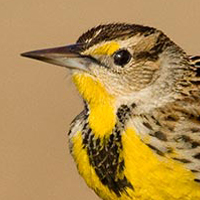Eastern meadowlark
Scientific name: Sturnella magna

Cover photo credit: Mark Peck
Status
Threatened
“Threatened” means the species lives in the wild in Ontario, is not endangered, but is likely to become endangered if steps are not taken to address factors threatening it.
Date added to the Species at Risk in Ontario List
January 13, 2012
Read the Assessment report
What it looks like
Meadowlark is a medium-sized, migratory songbird (about 22 to 28 centimetres long) with a bright yellow throat and belly, a black "V" on its breast and white flanks with black streaks. Their backs are mainly brown with black streaks.
They have pinkish legs, a long, pointed bill and a light brown and black striped head. Eastern Meadowlark’s song is composed of a series of two to eight clear, flutelike whistles, often slurred together and descending in pitch.
Where it lives
Eastern Meadowlarks breed primarily in moderately tall grasslands, such as pastures and hayfields, but are also found in alfalfa fields, weedy borders of croplands, roadsides, orchards, airports, shrubby overgrown fields, or other open areas. Small trees, shrubs or fence posts are used as elevated song perches.
Where it’s been found in Ontario
In Ontario, Eastern Meadowlark is primarily found south of the Canadian Shield but it also inhabits the Lake Nipissing, Timiskaming and Lake of the Woods areas.
What threatens it
This species increased when forests were cleared in eastern North America. However, as with many grassland birds, Eastern Meadowlark numbers are shrinking due to changes in land use and the loss of suitable habitat that has resulted from development, changes in farming practices, over-grazing of pasturelands by livestock, grassland fragmentation, reforestation and the use of pesticides.
Eastern Meadowlarks are also subject to predators, including foxes, domestic cats and dogs, coyotes, snakes, skunks, raccoons and other small mammals. In Ontario, the number of Eastern Meadowlarks has decreased by almost 65 per cent during the past 40 years.
Action we are taking
This species and its habitat are protected under Ontario’s Endangered Species Act, 2007 (ESA).
The ESA also requires us to prepare recovery guidance for threatened species such as Eastern Meadowlark.
All species listed on the Species at Risk in Ontario List may be eligible for consideration for government funding through the Species at Risk Stewardship Program.
Recovery strategy
A recovery strategy advises the ministry on ways to ensure healthy numbers of the species return to Ontario.
Read the executive summary (May 31, 2013)
Read the recovery strategy (May 31, 2013)
Government response statement
A government response statement outlines the actions the government intends to take or support to help recover the species.
Read the government response statement (December 15, 2015)
Review of Progress
A review of progress made toward protecting and recovering a species is required no later than the time specified in the species’ government response statement, or not later than five years after the government response statement is published if no time is specified.
Read the report on progress towards the protection and recovery of four species at risk, including Eastern Meadowlark (2020).
Habitat protection
General habitat descriptions are technical, science-based documents that provide greater clarity on the area of habitat protected for a species.
Read the general habitat description (July 2, 2013)
Species at Risk Conservation Fund
Eastern Meadowlark has been designated as an eligible species for the Species at Risk Conservation Fund.
Learn more about the Species at Risk Conservation Fund and how the Species Conservation Action Agency is working to help protect and recover conservation fund species.
What you can do
Report a sighting
Submit your observations of species at risk to the Natural Heritage Information Centre (NHIC), which is Ontario’s conservation data centre. Join the “(NHIC) Rare Species of Ontario” project in iNaturalist to make submitting your observations quick and easy.
Volunteer
Volunteer with your local nature club or provincial park to participate in surveys or stewardship work focused on species at risk.
Be a good steward
- Private land owners have a very important role to play in species recovery. If you find an Eastern Meadowlark nesting on your land, you may be eligible for stewardship programs that support the protection and recovery of species at risk and their habitats.
- As with all wildlife, don’t disturb or harass the birds or nesting sites. Be respectful and observe from a distance.
- The Canada-Ontario Environmental Farm Plan is available to eligible farmers to encourage greater protection and conservation of habitat for species at risk. Learn more.
Report illegal activity
Report any illegal activity related to plants and wildlife to
Quick facts
- Undertaking an activity near or affecting Eastern Meadowlark? Your activity may qualify for streamlined approval and registration. Read more.
- Eastern Meadowlarks can be beneficial in hayfields since they eat large numbers of insects that could otherwise be harmful to crops.
- This bird forages on the ground or in low vegetation, probing with its bill and mainly eating insects, but also seeds and berries.
- Eastern Meadowlarks can nest from early May to mid-August, in nests that are built on the ground and well-camouflaged with a roof woven from grasses.